
Easy Ways to Propagate Houseplants: Simple Techniques for Growing New Plants
If you love houseplants and want to expand your collection without spending a fortune, easy ways to propagate houseplants are your secret weapon. Whether you’re looking to multiply your favorite plants or share the joy of greenery with friends, propagation is a simple and rewarding process. In this guide, we’ll explore effective techniques that anyone can do at home—no gardening experience required. From cutting stems to dividing roots, you’ll discover how to grow new plants effortlessly and watch your indoor garden thrive. Let’s dive into these straightforward methods that will help you create a lush, vibrant space!
Table of Contents
ToggleWhy Propagate Houseplants?
Propagating houseplants offers a range of benefits that go beyond simply increasing your plant collection. Here are a few key reasons why you should consider propagating your houseplants:

Cost-Effective Planting: Buying new plants can get expensive, especially if you love growing your indoor garden. Propagating your current plants allows you to create new ones at little to no cost.
Sharing and Gifting: Successfully propagated plants make thoughtful gifts for friends and family. You can easily share your plant love by giving away cuttings that will grow into beautiful, thriving plants.
Preserving Healthy Varieties: If you have a plant you love, propagating it helps ensure you have a backup in case the original one faces health issues or doesn’t survive.
Learning and Satisfaction: The process of propagating houseplants is educational and rewarding. It helps you better understand your plants, giving you a sense of achievement as you watch new growth emerge.
Increased Plant Variety: Propagation opens up the possibility of experimenting with different plant varieties. Whether you’re trying to create new color variations or grow rare houseplants, propagation is a great way to expand your collection.
By propagating your houseplants, you not only expand your indoor garden but also nurture your passion for plant care and sustainability.
Understanding Different Propagation Methods
Propagation is a crucial step in growing new plants, and knowing the best method for your plant type can lead to better success and healthier growth. Here are the most common propagation methods:
Seed Propagation
Seed propagation is the simplest and most natural way to grow plants. It involves planting seeds, which then germinate into new plants. This method is perfect for gardeners with patience, as it often takes longer. Key tips:
- Choose high-quality seeds from a reputable source.
- Ensure proper soil preparation, light, and moisture for successful germination.
- Be aware of each plant’s specific temperature and humidity needs.
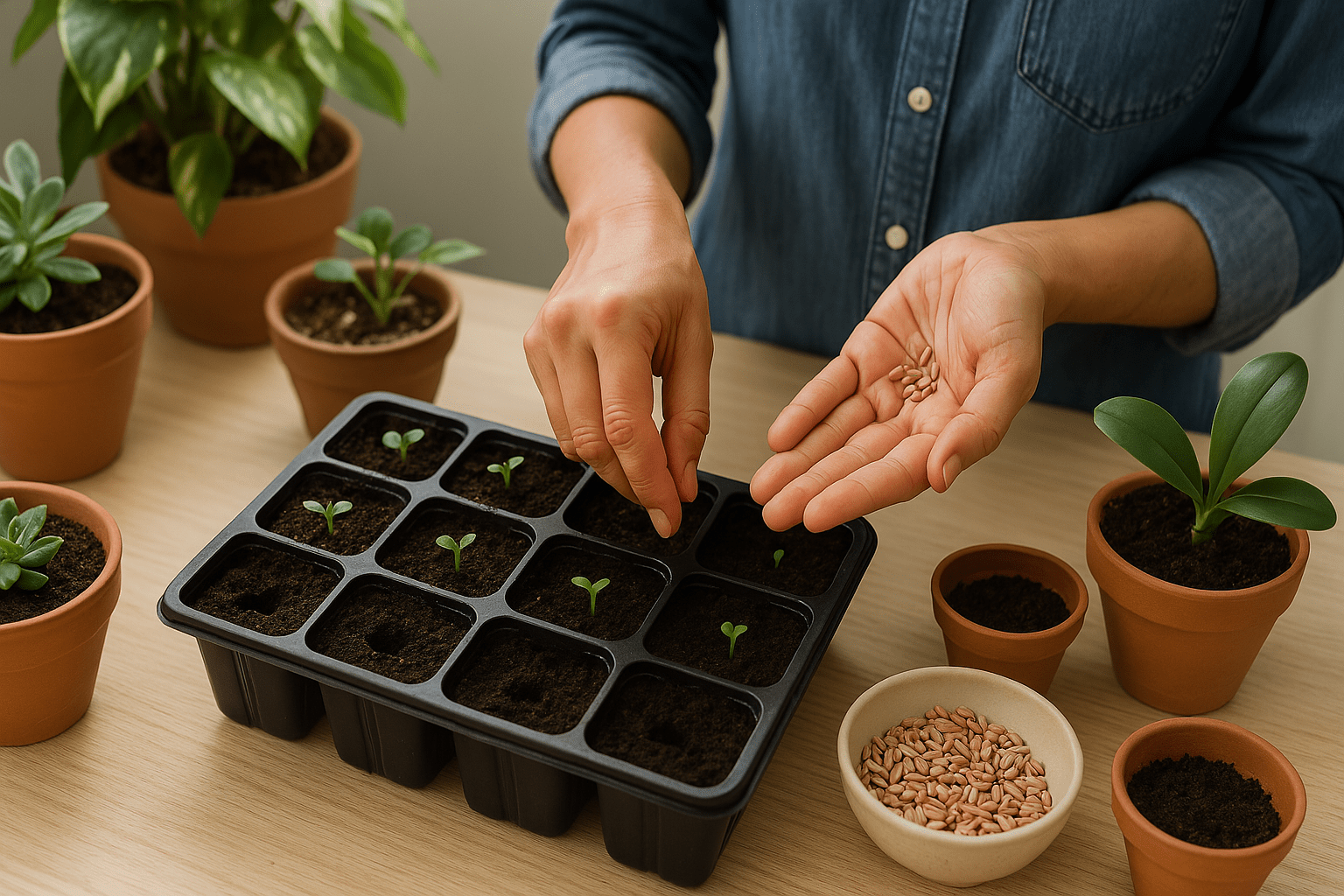
Cuttings
Taking cuttings is a fast and effective method, especially for shrubs and houseplants. This involves cutting a small part of a plant (usually a stem) and encouraging it to form roots in a growth medium. Key tips:
- Select healthy, non-flowering stems for better success.
- Use a rooting hormone to promote faster rooting.
- Keep the cutting in a warm, humid environment to encourage growth.
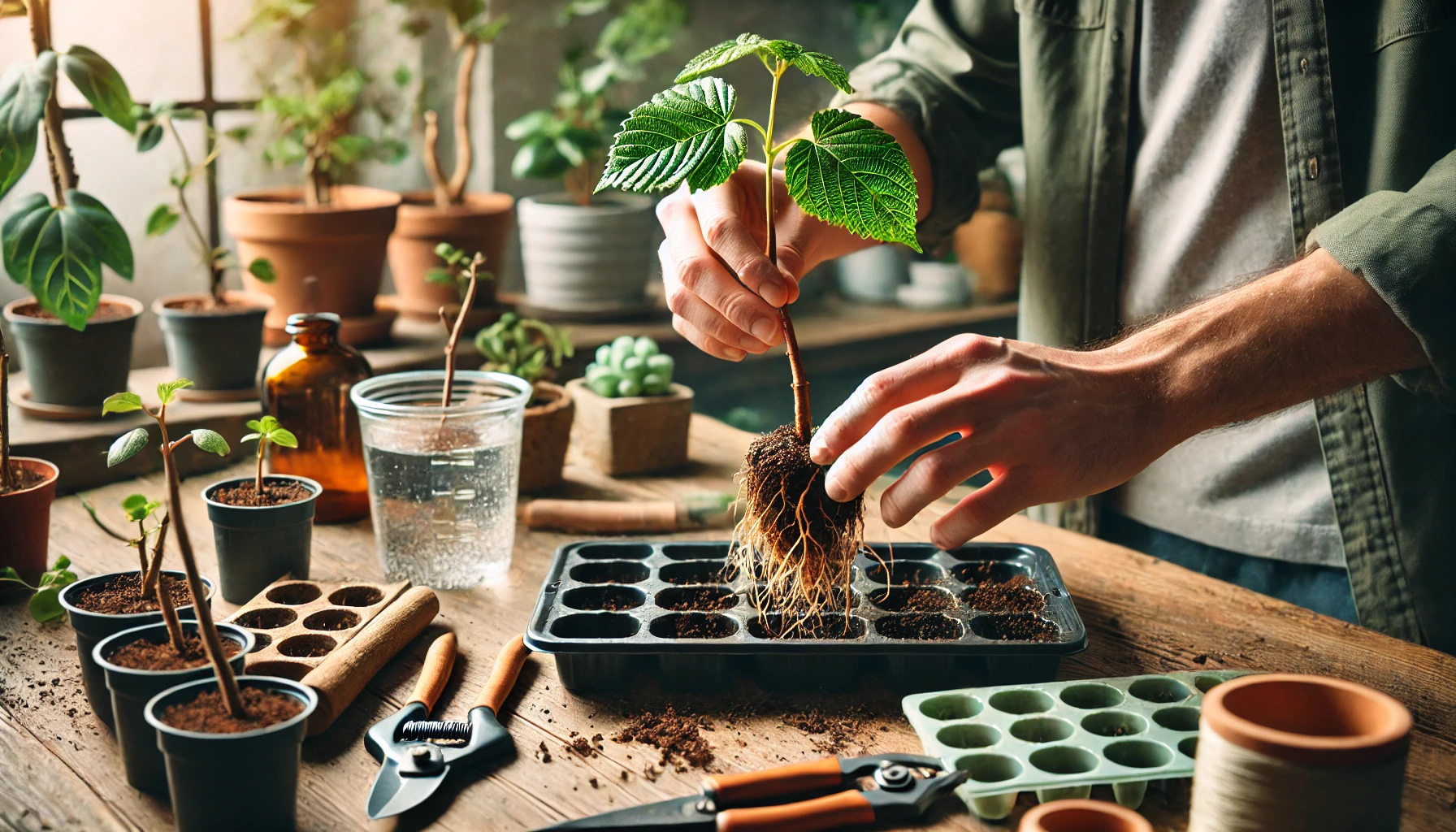
Division
Division works well for plants that naturally grow in clumps, like lilies or hostas. It involves separating the root ball into smaller sections, each capable of growing into a new plant. Key tips:
- Ensure each division has a healthy root system.
- Replant promptly to avoid damage to the roots.
- Choose the right season, typically in spring or fall, to minimize plant stress.
Layering
Layering is ideal for woody plants like blackberries and some shrubs. It involves bending a branch down to the soil and encouraging roots to form while still attached to the parent plant. Key tips:
- Select a low, flexible branch and secure it to the soil with a stake.
- Keep the soil moist, and after a few months, the branch will have rooted.
- Once rooted, separate the new plant from the parent.
Grafting
Grafting is often used for fruit trees and roses, where a piece of a plant is joined to the rootstock of another. This method requires a bit of expertise but can result in improved plant strength or disease resistance. Key tips:
- Align the cambium layers of both plants for successful grafting.
- Use proper tools and techniques to ensure the graft heals well.
- Graft during the plant’s dormant season for better success.
Understanding these propagation methods will help you select the best approach for your plants, ensuring successful growth and a flourishing garden.
Essential Tools and Materials for Propagating Houseplants
When propagating houseplants, having the right tools and materials is essential to ensure success. Here’s a list of the must-have items for smooth and effective plant propagation:
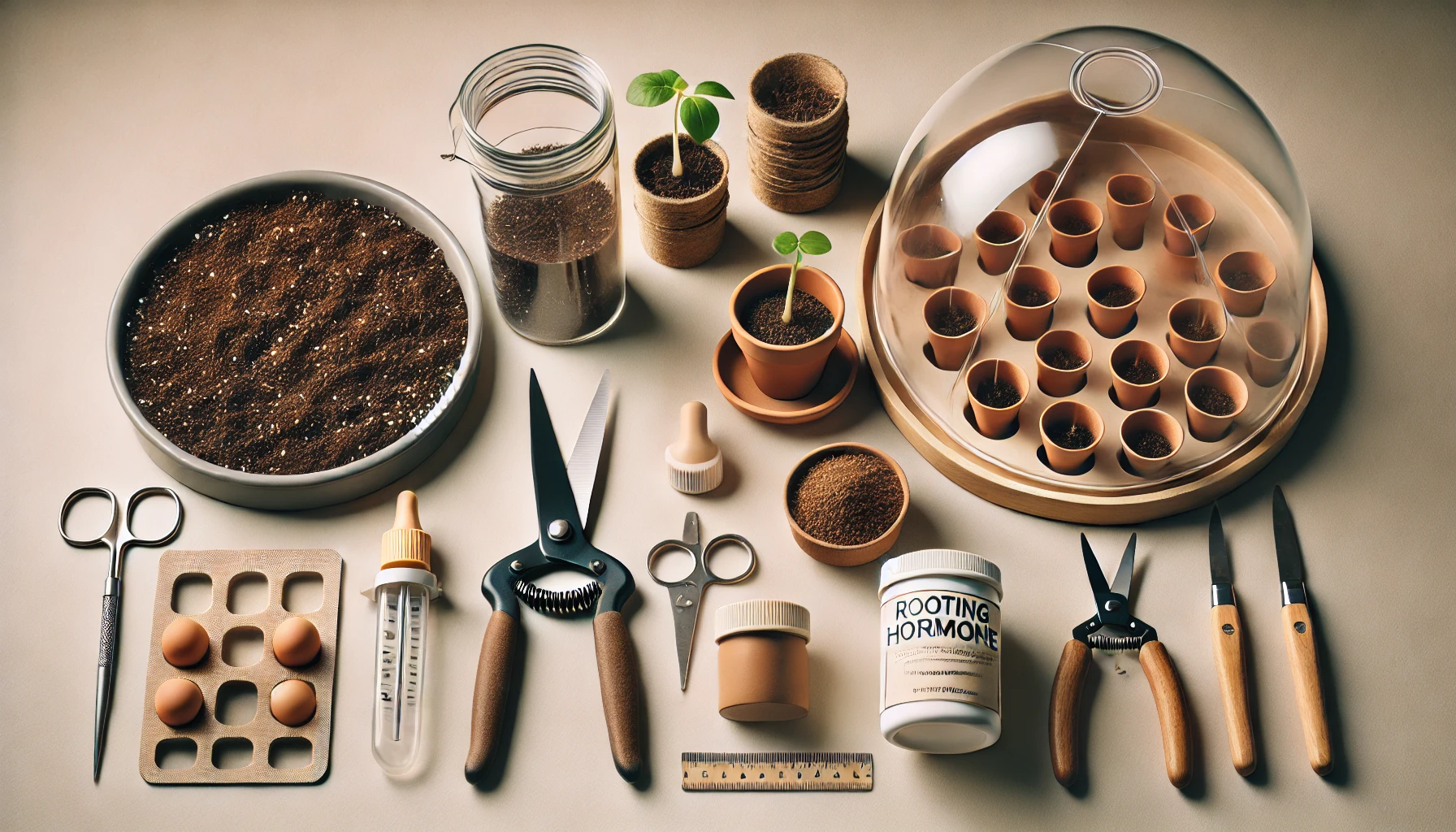
Sharp Scissors or Pruning Shears
Clean, sharp scissors or pruning shears are key to making precise cuts without damaging the plant. Make sure they’re disinfected to prevent the spread of diseases between plants.
Propagation Trays or Containers
A shallow container or propagation tray helps create the perfect environment for cuttings. It holds the soil or water and keeps the plant cuttings from getting too crowded.
Rooting Hormone
While not always necessary, rooting hormone can encourage faster root development. It’s especially useful for harder-to-root plants. Simply dip the cut end of the plant in the hormone powder before placing it in water or soil.
Sterilized Potting Mix
If propagating in soil, use a light, well-draining potting mix. A mixture of perlite and peat or coco coir provides the perfect medium for young roots to establish.
Clean Water or Hydrating Solution
If propagating in water, make sure to use clean water to avoid algae buildup. Change the water regularly to prevent stagnation and ensure healthy root growth.
Humidity Dome or Plastic Bags
A humidity dome or a simple plastic bag placed over cuttings helps maintain moisture and warmth, mimicking a greenhouse environment. This step is crucial for promoting root development in many plant species.
Grow Lights (If Necessary)
If your environment lacks natural light, grow lights are an excellent solution to provide your cuttings with the energy they need for healthy growth. Choose a full-spectrum LED light for best results.
By gathering these tools and materials, you’ll be well-equipped to propagate your houseplants effectively, giving them the best chance to thrive.
Best Time to Propagate Houseplants
Knowing the ideal time to propagate your houseplants is crucial for success. The best time to propagate houseplants is during their active growing season, typically in the spring and early summer. Here’s why:

Optimal Growth Conditions: During spring and summer, plants are naturally in a growth phase, producing more energy and resources. This boosts the chances of successful propagation.
Warmer Temperatures: Warm temperatures, between 65°F and 75°F (18°C to 24°C), create the perfect environment for plant cuttings to root. These conditions speed up the rooting process.
More Light: Longer daylight hours provide ample sunlight, which is essential for healthy rooting and growth of cuttings.
Avoid Winter Dormancy: In the colder months, plants enter dormancy, and their growth slows. Propagating during winter may result in weak or slow-growing cuttings due to limited energy.
For the best results, ensure you’re propagating during the plant’s natural growing period to maximize your chances of success. Timing your propagation efforts with the seasons makes it easier for your houseplants to thrive.
Common Challenges in Propagating Houseplants
Propagating houseplants can be a rewarding experience, but it comes with its own set of challenges. Here are some common issues you might face and practical tips to overcome them:
Root Rot Root rot is a common issue when propagating plants in water. If the cutting sits in water for too long, it may develop rot. To avoid this, change the water every few days, and ensure the cutting doesn’t touch the bottom of the container. If you’re propagating in soil, make sure it’s well-draining to prevent water from stagnating around the roots.
Slow or No Root Growth If you notice your cuttings aren’t developing roots, it could be due to insufficient warmth or humidity. Houseplants generally thrive in warm, humid environments, so consider placing your cuttings in a warmer spot or using a humidity dome. For faster root development, try using rooting hormone to encourage growth.
Overwatering Overwatering is a common mistake during propagation. Cuttings, especially in soil, need moisture but not excessive water. Too much moisture can suffocate the roots and promote fungal growth. Allow the top inch of the soil to dry out before watering again.
Pests and Disease Houseplant cuttings are susceptible to pests such as aphids or fungal infections. Always inspect cuttings before placing them in a propagation medium. Treat with insecticidal soap or neem oil to keep pests away. Clean and sterilize any tools you use to prevent the spread of disease.
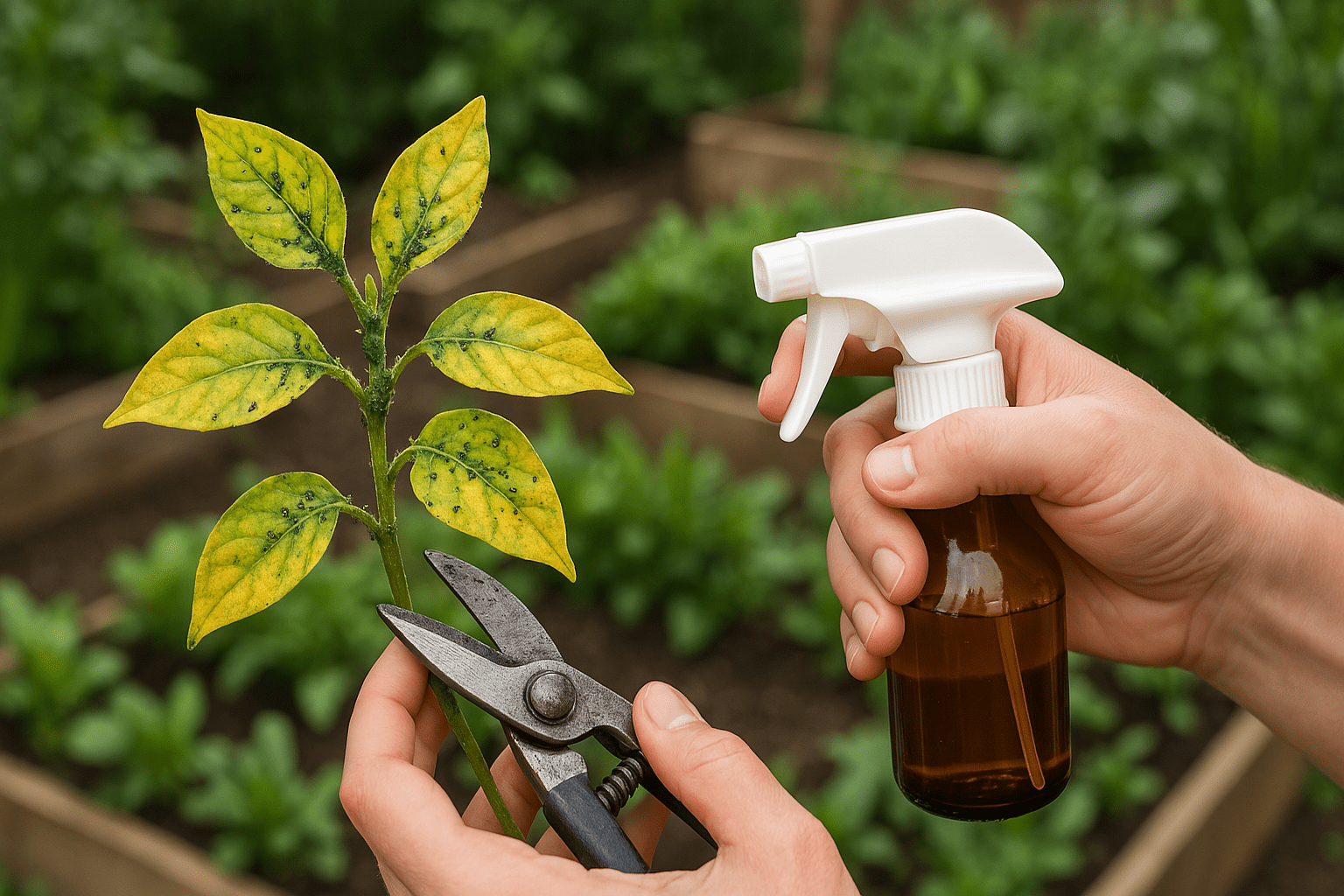
Light Stress While cuttings need light to root, too much direct sunlight can stress them out, leading to leaf burn. Place your cuttings in bright, indirect light to help them thrive. A south-facing windowsill with filtered light is ideal for most houseplants.
By addressing these challenges, you’ll increase your chances of successfully propagating houseplants and enjoy the process with less frustration.
Tips for Successful Houseplant Propagation
Successful houseplant propagation can be a rewarding experience for any plant lover. Whether you’re starting new plants or expanding your collection, here are some practical tips to ensure success:
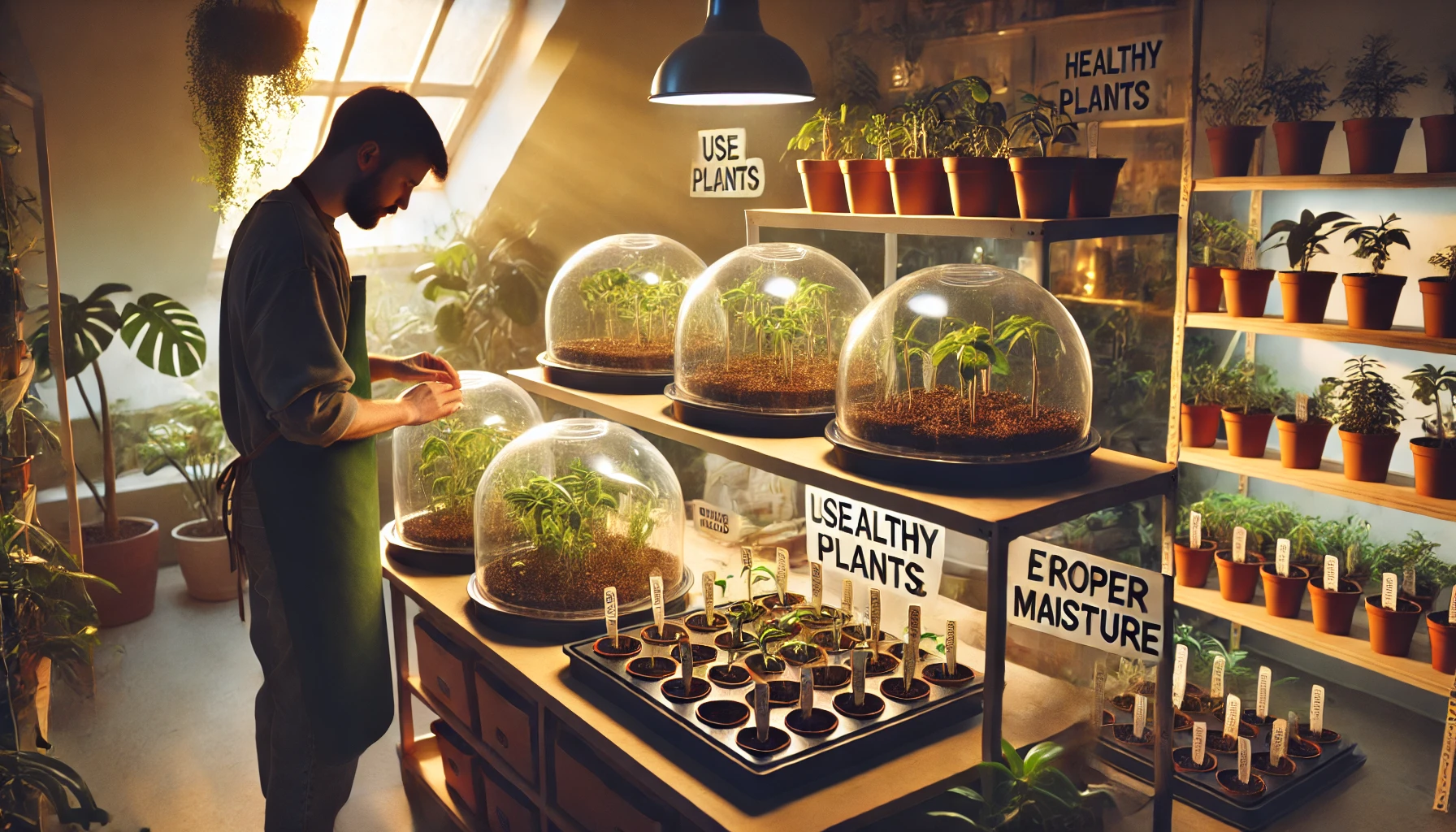
Choose the Right Plant
Not all houseplants are easy to propagate. Some popular choices include pothos, spider plants, and succulents. Research your plant to see if it’s suitable for propagation before starting.
Use Clean Tools
Always use sharp, clean scissors or pruning shears to cut stems. This helps prevent infections or diseases from spreading to your new plant.
Water Propagation vs. Soil Propagation
For beginners, water propagation is easier to monitor. Simply place the cutting in a jar of water and change the water regularly. For soil propagation, make sure to use a well-draining mix to avoid rotting.
Provide Proper Lighting
Ensure your cuttings receive bright, indirect light. Too much sunlight can stress the cutting, while too little can slow down root development. Keep them in a warm, well-lit spot.
Maintain Humidity
High humidity is key to root growth. Place a plastic bag or a humidity dome over your cuttings to keep the environment moist, but ensure there’s good air circulation to avoid mold.
Be Patient
Propagation takes time. Depending on the plant, roots can take anywhere from a few weeks to a couple of months to develop. Avoid rushing the process, and check regularly for signs of root growth.
Transplant Carefully
Once your cutting has established a healthy root system, transplant it into a pot with fresh soil. Don’t forget to water it well after transplanting to help it settle in.
By following these tips, you’ll increase your chances of success in houseplant propagation and enjoy the process of growing new, thriving plants for your home.
Learning easy ways to propagate houseplants is a fun and rewarding way to expand your plant collection while saving money. Whether you’re using stem cuttings, leaf cuttings, or water propagation, these simple techniques allow you to grow new plants and strengthen your connection with the green world around you. With the right tools, patience, and a little care, you’ll be able to nurture your propagated plants and watch them thrive.
So, why not start today? Choose a propagation method that suits your favorite houseplants, and begin your journey to a fuller, greener indoor garden. Happy propagating!
Frequently Asked Questions(FAQ)
What are the easiest ways to propagate houseplants?
Some of the easy ways to propagate houseplants include stem cuttings, leaf cuttings, and water propagation. These methods are beginner-friendly and work well for many popular houseplants like pothos, snake plants, and ivy.
How do I propagate houseplants from stem cuttings?
To propagate houseplants from stem cuttings, simply take a healthy cutting with at least 2-3 inches of stem and a few leaves. Place the cutting in water or directly into a moist potting mix. Ensure the cutting gets indirect light and keep the soil or water moist until roots develop.
Can I propagate houseplants in water?
Yes, many houseplants, like pothos and philodendron, can be propagated in water. Place the cuttings in a jar with enough water to cover the base of the stem but not submerge the leaves. Change the water regularly, and once roots form, you can transplant the cutting into soil.
When is the best time to propagate houseplants?
The best time to propagate houseplants is during the growing season—typically spring and early summer—when the plants are actively growing. However, you can still propagate in winter, but it may take longer for roots to develop due to lower light levels.
How long does it take for propagated houseplants to root?
The time it takes for propagated houseplants to root depends on the method and plant type. Typically, it can take anywhere from a few weeks to a couple of months for roots to form, especially when propagating in water.
Can I propagate houseplants using leaf cuttings?
Yes, many plants like snake plants, African violets, and begonias can be propagated using leaf cuttings. Simply cut a healthy leaf, place it in soil or water, and wait for new roots to form. Some plants may take longer, so patience is key.
How can I prevent rot while propagating houseplants?
To prevent rot during propagation, ensure that the cuttings have proper drainage, avoid overwatering, and use clean tools when taking cuttings. For water propagation, change the water regularly and avoid letting the cuttings sit in water for too long.
Do I need special tools for propagating houseplants?
No, you don’t need anything special, but a sharp pair of scissors or pruning shears, clean containers, and quality potting mix can help. A rooting hormone can also be useful for promoting root growth, although it’s not always necessary.

